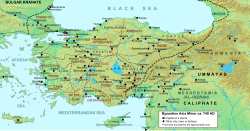| Siege of Nicaea | |||||||
|---|---|---|---|---|---|---|---|
| Part of the Arab–Byzantine Wars | |||||||
 Map of Anatolia (Asia Minor) in 740 AD. Nicaea is located at the northwestern corner of the Anatolian peninsula | |||||||
| |||||||
| Belligerents | |||||||
| Byzantine Empire | Umayyad Caliphate | ||||||
| Commanders and leaders | |||||||
| Artabasdos |
Mu'awiya ibn Hisham Abdallah al-Battal | ||||||
The siege of Nicaea of 727 was an unsuccessful attempt by the Umayyad Caliphate to capture the Byzantine city of Nicaea, the capital of the Opsician Theme. Ever since its failure to capture the Byzantine Empire's capital, Constantinople, in 717–718, the Caliphate had launched a series of raids into Byzantine Asia Minor. In 727, the Arab army, led by one of the Caliph's sons, penetrated deep into Asia Minor, sacked two Byzantine fortresses and in late July arrived before Nicaea. Despite constant attacks for 40 days, the city held firm and the Arabs withdrew and returned to the Caliphate. The successful repulsion of the attack was a major boost for Byzantine emperor Leo III the Isaurian's recently initiated campaign to abolish the veneration of icons in the Empire; Leo claimed it as evidence of divine favour for his policy. The siege of Nicaea marks also the high point of the Umayyad raids, as new threats and defeats on their far-flung frontiers decreased Umayyad strength elsewhere, while Byzantine power strengthened afterwards.